Hair porosity refers to your hair’s ability to attract and retain water inside the hair strand, and this has a direct relation to how the cuticle layers lie in your hair strand. I have discussed this topic in a series of blog posts where I talked about different aspect of natural hair, and how they affect the way we care and choose hair products. You can start reading this series here if you want to. Today I want to go even deeper and talk about how to improve hair porosity. Warning, this will be a long post!
There are three types of hair porosity: low, medium and high. Low porosity can be identified when the hair layers are tightly closed together making water absorption very difficult and therefore, putting the hair at dehydration risk, which means dry and brittle hair. High porosity, on the other hand, happens when the cuticle layers of the hair are open allowing free water intake. Unfortunately, the layers stay open and are unable to retain water and hair become dry. Lastly, medium porosity is when the cuticle layers of the hair are compact and flexible enough to attract and retain moisture. This is what many people desire, hair that is healthy, has elasticity and is easy to style.
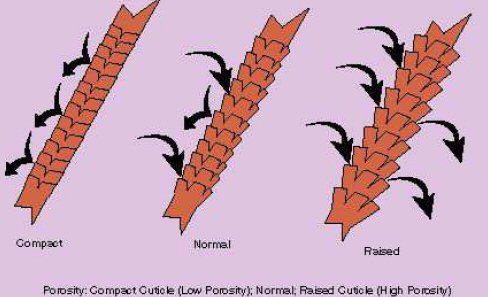
Natural Characteristics That Affect Hair Porosity
Hair type can influence porosity in naturally curly hair in the sense that the curlier/kinkier the hair is the more likely it is that it has high porosity. The places where the hair bends to form curls, sometimes at 180˚ degree angle, is where the cuticle layers open because they are unable to close making the hair more porous (high porosity). On the other hand, undamaged straight/straighter hair has its cuticle layers overlapping each other and, therefore, closed – natural curly hair is different.
Another characteristic that can possibly affect hair porosity is hair texture. Although hair porosity can affect fine, medium and coarse hair it is known that coarse hair is more resistant to styling and chemical treatments. This can be understood as hair that has low porosity. The cuticle layers are so closed that moisture and chemical treatments have difficulty getting in. However, hair type can also influence hair porosity. If the hair is coarse and kinky/coily it may not have low porosity.
How Does Damage Happen?
Before I go into discussing what affects hair porosity, I would first like to give you an idea of what damage looks like in the hair strand. Hair is composed of water, lipids, melanin and its main component keratin (a protein). The cuticle layers are the first line of the defence of our hair and when they suffer/endure prolonged damage they can be chipped, lifted, broken or left with holes. The extent of these injuries eventually reaches the cortex, which is mainly composed of keratin and other protein-like bonds that are now weakened and will possibly break. These injuries affect hair porosity.
So how does damage happen? What is it that we do or don’t do that affects hair porosity? Let’s move on and identify what happens. The porosity of your hair can be impaired in many ways. Chemical treatments are not the sole culprits when talking about this matter. There are other influences that play an important role as well and are critical to know so you can first prevent and protect your hair from further harm. Let’s get to know some of the “dark forces”.
- Environmental Causes – Hair exposure to the sun, the wind and cold weather affects our hair. Prolonged sun exposure causes an adverse reaction to your hair. It starts out by losing its moisture, becoming dry and dull and then losing elasticity and protein. Wind and cold, as you may know, dry out our hair. Constant changes between the cold weather outside and warm temperatures when inside, cause the hair cuticles to open and moisture to be lost. Strong and repetitive gusts of wind tangle the hair, this causes friction, increases hair tangles and can possibly result in split ends and knots. (Read Natural Sun Protection For Your Hair)
- Exposure to Salt and Chlorine – During summer time, it is nice to refresh ourselves under high temperatures and what better way to do that then to go to the beach or swimming pool. It certainly feels good, but our hair suffers from it. Salt and chlorine leave our hair dry, dull, fragile and with weakening protein bonds. (Read Transitioning Hair And Swimming – Protective Measures, 3 Hair Care Solutions After Swimming)
- Manipulation – this refers to the way we manipulate our hair when shampooing, combing, towel drying and styling our hair. Vigorous action increases the potential for hair damage. Again, the friction, the pulling and stretching actions can damage the cuticle layers and protein bonds. (Read Reduce Hair Breakage When Washing Transitioning Hair)
- Chemical Treatments – Whenever we submit our hair to harsh chemical treatments it suffers irreparable damage. Relaxing, dyeing and bleaching impose a huge punch on the hair’s first line of defence. The cuticle layers can suffer in various manners as previously mentioned. When this happens an “open door” is left exposing the protein bonds, leaving them defenceless to further and continued damage. Hair porosity is then changed. If you want to dye your hair why not try henna?
- Heat Styling – The use of heat on our hair isn’t a bad thing. Heat can be a powerful partner in hair care, the problem arises when it’s used inappropriately – frequent use of high temperatures when blow drying and flat ironing. Imagine the water/moisture inside your hair being boiled to the point of evaporation while at the same time hair fibres/bonds are being stretched. A tortuous image, isn’t it? But this isn’t over, when you wash your hair it will revert back to its original nature. This repeated pattern of stretching and shrinking the hair will damage protein bonds. The hair loses its elasticity (inability to revert to its curl pattern) and eventually, the bonds are broken and hair porosity is changed. You now have heat damage too! (Read Flat Irons ABS – Know The Lingo, Avoid The Woes!)
- Long Hair – Say What?! Yes, you read right. According to scientist blogger, on The Natural Haven Bloom, long hair can contribute to this long list just because it has been exposed several times to shampooing, towel drying and combing. (Read 10 Cons Of Having Natural Long Hair)
The list is long and it looks like there is nothing we can do to improve hair porosity given that anything we do to our hair can potentially damage it. It may look that way, but there are some things that can be done in your hair routine that can improve hair porosity.
Improving Low Porosity Hair
One of the main complaints from those with low porosity is the fact that products just seem to sit on the hair and create product build-up. It certainly looks that the “ability” to repel moisture would make low porosity hair dry and straw-like or feel heavy, sticky and greasy. This can obviously be the case. However, low porosity hair can also be healthy, strong and elastic because once moisture is “accepted” into the hair it is very hard to be released. So if you’re included in this category you have a good opportunity to have beautiful hair. Here are some tips.
- Oil Pre-poo – Whether you shampoo or co-wash doing an oil treatment before you do cleanse your hair can be beneficial. Although this may sound counter-intuitive and that oils would just seat on top of the hair strand the difference is on what oils you use. Oils with small molecular weight are able to penetrate the cuticle layers of the hair such as coconut oil and olive oil. You can check for evidence in this study and this one. Once inside the hair structure oils can retain moisture. You can reap more benefits if some heat is applied as it would help open the cuticle layers allowing easier penetration of the oils. Simply apply oil to your hair, place a plastic cap or bag on it and let it sit for as long as possible, preferably overnight (your scalp will produce a nice and warm temperature). (Read Should You Pre-Poo Your Hair?)
- Alkaline Solutions – Refers to the use of baking soda on the hair which seems to make the hair more porous. Many swear by this method and report their low porosity hair retains more moisture after using baking soda. However, not all hair reacts the same way, some may be more sensitive to alkaline and different results can be achieved. The science-y hair blog alerts to the use of baking as being harsh to the hair, and its use can potentially and permanently alter your hair porosity and hair texture. Advice is given to mixing baking soda with yoghurt or conditioner because it is less abrasive than water/baking soda. (Read Baking Soda For Hair Care)
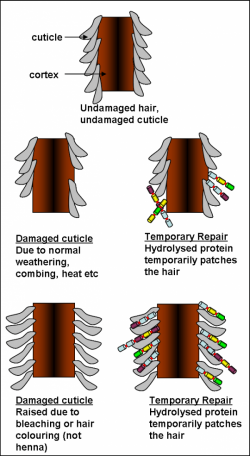
- Moisturising/Protein Deep Conditioner – For low porosity hair to profit with the use of deep conditioners a source of heat or steam must be applied which will open the layers of the hair. For more intense benefits add some vegetable oils which will moisturise it further, and don’t forget to make this a weekly practice. Additionally, include a protein treatment only once or twice a month always followed by a moisturising deep conditioner as protein can make hair feel dry and hard. Although some people run away from the use of protein, protein can actually help retain moisture. Protein is a collection of long chain amino acids that can be broken into small segments, through the process of hydrolyzation. If it has been broken down enough protein will penetrate/stick and form bonds with the hair and once there it will retain moisture. Look for hydrolyzed silk, rice or wheat protein.
- Steam/Heat – these two can really work as catalysts on oil pre-poo treatments and with deep conditioners. Heat and steam make product ingredients more “liquidy” and able to thoroughly cover hair strands. Additionally, hair cuticles are raised and your hair can be moisturised more efficiently. Steam has an added benefit, it spreads a mist of water vapour around the hair and further supplements the moisturising effects of deep conditioning.
Improving High Porosity Hair
High porosity hair is often considered dry, frizzy, lacking in flexibility and elasticity. This is really unfortunate given that it absorbs water like a sponge. However, it releases it just as quickly. This distinctive feature in high porosity hair also means that it can easily break. Because the cuticle layers are constantly open they can simply be broken or chipped through friction, and continued damage can reach the cortex and inevitably “injure” protein bonds. High porosity hair can frequently be found in curly and kinky girls and it can be a natural feature of the hair due to its texture or one that is the result of the inflicted damages discussed earlier here. However, don’t despair there are things you can do to improve your high porosity.
- Oil Pre-poo – When doing an oil pre-poo, coconut oil will be your best friend. This oil is highly praised in the natural hair community and it’s no wonder. Coconut oil has been proved to penetrate the structure of the hair, prevent protein loss and hygral fatigue. When high porosity hair is washed the hair strands enlarge and become heavier from water intake, and manipulation makes it highly prone to breakage. Coconut oil will lessen your hair’s vulnerability. However, you can also use other oils as long as they have a small molecular weight such as safflower oil. (Read What is Hygral Fatigue?, 5 Tips To Prevent Hygral Fatigue)
- Moisturising/Protein Deep Conditioning – Just as with low porosity hair deep conditioning and mixing in vegetable oils can help moisture retention within the hair. Protein treatments should also be included in your hair routine, protein in high porosity hair will strengthen as well as fill, repair and coat all the cracks and holes in the hair. You will be able to diminish and prevent breakage. Look for conditioners with penetrating proteins such as hydrolyzed silk or wheat or proteins with a bigger molecular structure that can fill and coat any space or hole such as oat or corn.
- Apple Cider Vinegar Rinse (ACV) – This is another simple home remedy that produces results for
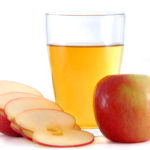 many curly girls. ACV is said to help remove product build up, treat dandruff and hair loss and balance the hair’s ph. When hair is rinsed with a mixture of ACV and distilled water the cuticles layers of high porosity hair close and moisture is retained. However, caution is advised as ACV is very acidic which can be irritant to the hair and harsh for the hair. Start with a small amount of ACV in the mixture, see how your scalp and hair react and increase gradually if you feel you need to, up to a ratio of 1:3 (ACV:Water). (Read The Benefits of Apple Cider Vinegar For Natural Hair)
many curly girls. ACV is said to help remove product build up, treat dandruff and hair loss and balance the hair’s ph. When hair is rinsed with a mixture of ACV and distilled water the cuticles layers of high porosity hair close and moisture is retained. However, caution is advised as ACV is very acidic which can be irritant to the hair and harsh for the hair. Start with a small amount of ACV in the mixture, see how your scalp and hair react and increase gradually if you feel you need to, up to a ratio of 1:3 (ACV:Water). (Read The Benefits of Apple Cider Vinegar For Natural Hair)
- Oil/Butters – They seal, lubricate and provide slip, and some can even penetrate the hair strand. Oils and butters have essential fatty acids (EFA) which are also present in hair sebum. They successfully work in retaining moisture and preventing its loss in dry climates. Don’t forget to hydrate the hair before you apply these otherwise, you won’t retain any moisture you will seal the hair and prevent any possible moisture from getting in. (Read Penetrating or Sealing Oils)
- Humectants – These are frequently used in hair products and they are good for high porosity hair because they attract/are attracted to water. Glycerin and panthenol are humectants that absorb water and decrease the rate of water evaporation in the hair. By retaining moisture, the hair is kept hydrated and breakage is minimised. However care must be taken as they can not only take water from can not only take water from the air and the products you apply, but they can also take water from the hair itself. Make sure to use glycerin or products containing it at optimal dew point, which is between 40F to 60F (4˚C to 15˚C).
Final Considerations!
-
- In order to protect your hair from damage always use a scarf or hat in sunny, windy or cold weather.
-
- Hydrate your hair regularly especially the ends, they are more porous as they have “lived” longer. There are several mixtures you can make such as a water and aloe vera (very hydrating).
-
- Those with low porosity hair need time for moisture to “sink” any hair treatment will need at least 30 minutes to do its job. However, if you’re using a steamer this will be quicker 15 minutes will probably do.
-
 Always protect your hair when going out to swim in a pool or beach. My tip is to wet your hair, seal in the moisture with a vegetable oil (it makes it hard for salt and chlorine to be absorbed), do an easy/quick protective style and always try to rinse your hair with water before you lay on your towel to sunbathe (I always carry around a big bottle of water just in case!).
Always protect your hair when going out to swim in a pool or beach. My tip is to wet your hair, seal in the moisture with a vegetable oil (it makes it hard for salt and chlorine to be absorbed), do an easy/quick protective style and always try to rinse your hair with water before you lay on your towel to sunbathe (I always carry around a big bottle of water just in case!).
-
- Reduce the use of heat or use lower temperatures. Blow drying or flat ironing take all moisture from your hair. Don’t forget to use a heat protectant if you use heat.
- Avoid dyeing your hair, you know how bad it is for your hair. Have you tried using henna? You should definitely stay away from bleaching, it is worse than dyeing, it takes your natural hair colour, it can’t be good! (Read Henna For Hair Care)
This is a looong blog post and more could be said about hair porosity, however, I will leave that for future posts. I hope I have provided you with valuable information that will help improve your hair porosity and/or prevent further damages.
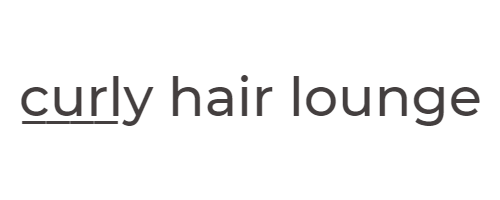
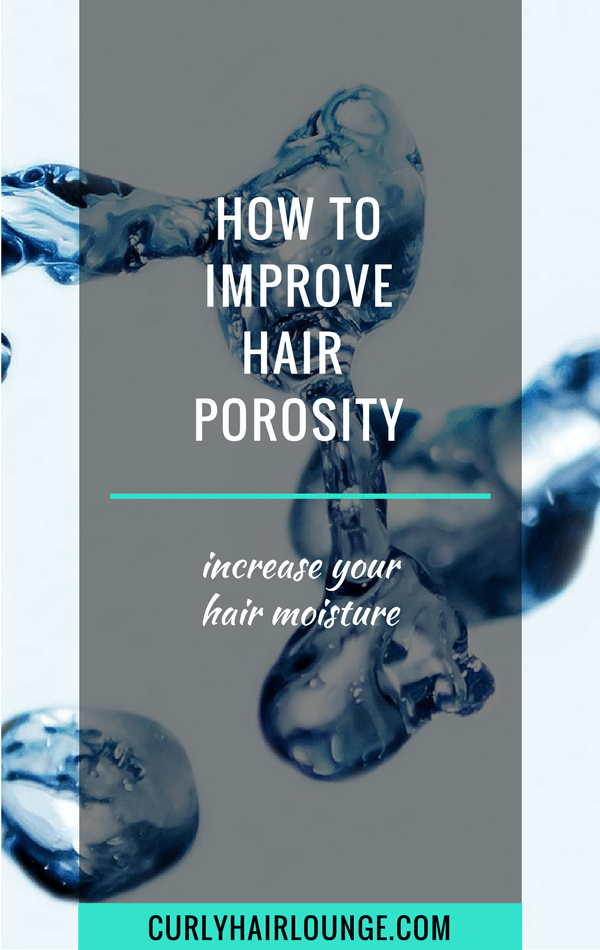

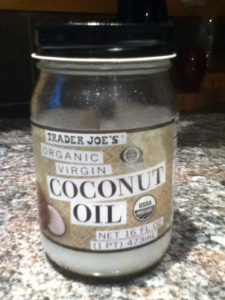
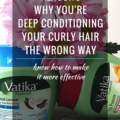
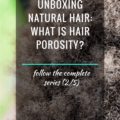

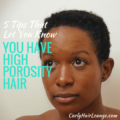
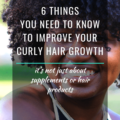
20 thoughts on “How To Improve Hair Porosity”
Very nice and informative post. My husband have hair problems and I will send the link to him 🙂
Hi Demi! I’m glad you like the post. Yes, please pass this post to your husband, many times we forget that men also care about their hair (well some do!).
Hi Monica! Excellent piece of information about hair porosity. Congratulation on this post!
Thank you so much Chance! 🙂
I can’t believe you only have 4 thoughts ! This was probably one of the most helpful articles I have read. I will share this with my friends on Facebook who willc certainly enjoy this article! Thank you so much for this post!
Wow, Nichole, thank you for your feedback. You made my day! Yes, please share if you think your friends will benefit from this article. 😀
I am confused. Alot of articles seem to state that cocunut oil and olive oil are not good for low porosity hair and suggest lighter oils like grapeseed, sweet almond, or argan. The reasoning behind it was that coconut oil will just sit on the hair as it is too heavy, as grapeseed is lighter and will not be too heavy on the low po hair, which is already prone to difficulty with letting in moisture. I have been reading so many articles trying to figure my hair out because there just seems to be so much different information that contradicts itself.
Hi Johana,
Yes, navigating the net can be confusing with all the misleading information. However, when it comes to coconut oil most people agree (I haven’t read the contrary) that it is a penetrating oil. Studies have proved this fact and also that it helps prevent protein loss in hair. It is a light oil that penetrates and leaves a small film around the hair strand. Olive oil is a penetrating oil but takes a while to absorb into the hair strand, therefore it will feel heavier for low porosity hair ( only use it for concoctions, oil mixes, my overnight pre-poo). Argan oil is also a penetrating oil, but Almond and Grapeseed are not penetrating oils, they are sealing oils (will sit on top of the hair strand). Grapeseed is a light sealing oil I like it quite a lot and used throughout my transitioning hair journey. I have low porosity hair and now use coconut oil in my hair regimen.
For low porosity hair use penetrating oils or light sealing oils (grapeseed, almond, jojoba which mimics our hair’s sebum). You can read this post to know more about sealing and penetrating oils or this one.
One reason why coconut oil can be considered by some as heavy is that it is a comedogenic oil (the degree – 0 to 5 – to which oils and emollients can clog pores, with ‘0’ being it doesn’t clog and ‘5’ being it’s highly likely to clog. Coconut oil scores 4). Also, in low/cold temperatures coconut oil becomes solid, and if you use it on your hair in cold climates and go outside it may create a white film on your hair.
Hope I cleared things up, Johana.
I’m only on 2nd month of this journey, and I’d cry for happiness. It has been so difficult some days, to go on work with terrific mess on my head. But I had hold on and I’m proud of it. Now I’m starting to see first results, and oh my God! So, thank you for theese useful info. Only, I dye my hair (not bleach, only dye my brown natural colour to cover gray roots). I’m thinking to return to henna, which I’ve used in the past. The only problem is the time it’s required. But I think it would be a great game changer. Thank you again from Italy. Chiara
Hi Chiara! I’m glad you find the info in the blog useful, that is the purpose. 🙂 As for dyeing your hair, henna can indeed be time-consuming and messy but has many benefits. You can also look for a good professional to do the work (I don’t trust over the counter boxes) and deep condition regularly, trim regularly… you know all those good hair care practices. 😀
Hi. I’m a twenty-year old with low porosity hair and heat damage. I’ve recently invested in the Shea moisture low porosity line and I’ve noticed my hair has gotten softer, but a I feel like moisturizing won’t cut it. I put the leave in conditioner/detangelar in then seal it with grapeseed oil. How often should I mositurize? Would finger dentangaling be considered manipulation? I’m natural and I’m worried that my curls will not comeback since I am now realizing that I have heat damage and I’m very inexperienced and uneducated with how to deal with my 3c natural hair. Thanks! If you could I direct me to more information I’d really appreciate it!
Hi Chanel! Moisturised hair is a behaviour. When it’s moisturised it moves, it bounces, it holds styles, it doesn’t look/feel dry… It’s how your hair behaves. It shouldn’t be something you have to do every other day. Once your hair is hydrated (has water in the internal structure) it will hold on to it 3-7 days, it will depend on your climate. If you are cleansing and conditioning your hair well and using the right styling product to achieve the style you want you should be okay. However, if you’re using oils and not removing them properly you can be doing some harm to your hair. Instead, look for products that are water-based and mainly use ingredients that are natural or naturally derived. Stay away from products that have lots of butters and oils in first ingredients.
Yes, detangling is considered mechanical manipulation and too much can cause damage (breakage/ split ends). If your hair is damaged you can cut the damage or let it grow as you gradually cut it (hair transition). You can look for more info here and here, but there are lots of info in the blog you search. Ultimately, you can always book a call with me.
Reading this article in 2019 and found it very useful and helpful. After years of research on websites and on YouTube, this articles contains some of the best information on hair porosity. I am low porosity
Thank you Janet, super glad you find this post informative. 🙂
Hi,
Thank you for the great article. I’m a 33 years old male and I have a normal wavy hair. I found out recently that my medium to slightly long hair is high porosity due to the severe hair damage and breakage inflected by mechanical stress (brushing) and using cotton towel to dry my hair. My hair soaks water in few seconds and gets frizzy and dry after toweling it. This also caused split ends and hair fall. I started using sulfate free shampoo and conditioner and a microfiber towel to pat dry my hair. I finish off my shower with cold water. I also use argon oil on my damp hair to retain some moisture. The frizz is much less now however I feel that my hair still feel sticky and damaged. When I run my fingers through my hair I can feel the damaged cuticles. I’m afraid that the damage has reached the cortex. Can a protein treatment help in repairing hair damage or is it a better idea to trim down my hair and start from the beginning? I will try ACV rinse for my sticky hair problem to remove the build up but do you have a recommendation for any clarifying shampoo that I should use after a pre-poo coconut oil or any sulfate free shampoo would suffice to do the job?
What I understood so far is that the following is the correct order to tackle a high porosity hair:
1. Pre-poo coconut oil
2. Sulfate free shampoo
3. Protein treatment (once every month)
4. Rinse out conditioner or deep conditioner
5. Apple Cider Vinegar (ACV) rinse.
6. Cold water rinse.
7. Leave in conditioner
8. Sealing oil (Shea butter).
Correct me please if I’m missing anything and thank you again!
Hi Ali!
Brushing can indeed cause mechanical damage to your hair, but so can other elements. Improper hair routine or poor quality products that don’t address hair needs, for instance. Trimming is always a good solution to get rid of hair damage even if just a little. If your hair feels sticky you may need to clarify your hair especially if you’re using natural oils or butter directly on your hair and don’t clarify. How often will depend on how often you use such ingredients as they can quickly cause buildup even with the use of a sulphate free shampoo.
As for a high porosity hair routine, coconut oil pre-pooing is great to prevent moisture loss and breakage. A protein treatment maybe needed more often than once a month depending on hair condition. Also, the strength of that hair treatment has to be taken into consideration too (there are, several. I go deep into this in my Curly Guide to Deep Conditioning). An ACV and/or a cold water rinse can help, but only if you’re up for the extra work. Throughout my research and personal experience, I have come to know that any conditioner/deep conditioner closes your hair cuticles. (here are some more curly hair rules you don’t need to follow). Finally, you can use a light oil to delay moisture loss, but use it sparingly on your wash day. After that, you’re just blocking your hair from getting moisture from the air, you’re also making your hair sticky/oily and causing extra buildup. If you find you need moisture a few days after your wash day it is best to wash it again.
I hope this helps, Ali. 🙂
Hi Monica, I just read your article. My head is so dry & I am facing low porosity hair problem. Thanks for sharing this article for improving the hair porosity. I will buy Pre-Poo Coconut Oil & I hope this oil will solve my problem. Have you ever faced a low porosity hair problem?
Hi Charlotte, is your hair or scalp dry? Or is it both? Low porosity may be a natural characteristic of the hair or, more often, as a result of heavy use of raw oils and butter. Heavy use of oil will prevent hydration to the hair and scalp and cause dryness. It’s important that you review your hair routine to know if you really are low porosity or if it’s the result of your hair routine.
your blog is very informative.
Thank you! 🙂